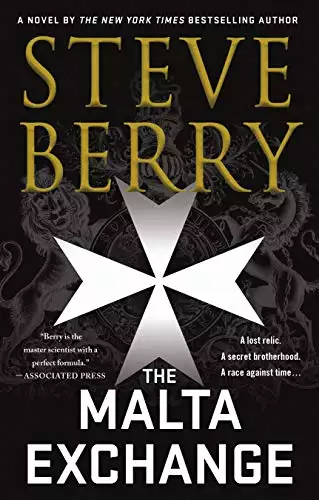CHAPTER ONE
TUESDAY, MAY 9
LAKE COMO, ITALY
8:40 A.M.
Cotton Malone studied the execution site.
A little after 4:00 P.M., on the afternoon of April 28, 1945, Benito Mussolini and his mistress Claretta Petacci were gunned down just a few feet away from where he stood. In the decades since, the entrance to the Villa Belmonte, beside a narrow road that rose steeply from Azzano about half a mile below, had evolved into a shrine. The iron gate, the low wall, even the clipped hedges were still there, the only change from then being a wooden cross tacked to the stone on one side of the gate that denoted Mussolini’s name and date of death. On the other side he saw another addition—a small, glass-fronted wooden box that displayed pictures of Mussolini and Claretta. A huge wreath of fresh flowers hung from the iron fence above the cross. Its banner read EGLI VIVRÀ PER SEMPRE NEL CUORE DEL SUO POPOLO.
He will always live in the hearts of people.
Down in the village he’d been told where to find the spot and that loyalists continued to venerate the site. Which was amazing, considering Mussolini’s brutal reputation and the fact that so many decades had passed since his death.
What a quandary Mussolini had faced.
Italy languishing in a state of flux. The Germans fast retreating. Partisans flooding down from the hills. The Allies driving hard from the south, liberating town after town. Only the north, and Switzerland, had offered the possibility of a refuge.
Which never happened.
He stood in the cool of a lovely spring morning.
Yesterday, he’d taken an afternoon flight from Copenhagen to the Milan–Malpensa Airport, then driven a rented Alfa Romeo north to Lake Como. He’d splurged on the sports car, since who didn’t like driving a 237-horsepowered engine that could go from zero to sixty in four seconds. He’d visited Como before, staying at the stunning Villa d’Este during an undercover mission years ago for the Magellan Billet. One of the finest hotels in the world. This time the accommodations would not be anywhere near as opulent.
He was on special assignment for British intelligence, working freelance, his target an Italian, a local antiques dealer who’d recently crept onto MI6’s radar. Originally his job had been a simple buy and sell. Being in the rare-book business provided him with a certain expertise in negotiating for old and endangered writings. But new information obtained last night had zeroed in on a possible hiding place, so the task had been modified. If the information proved correct, his orders were now to steal the items.
He knew the drill.
Buying involved way too many trails and, until yesterday, had been MI6’s only option. But if what they wanted could be appropriated without paying for it, then that was the smart play. Especially considering that what they were after did not belong to the Italian offering it for sale.
He had no illusions.
Twelve years with the Magellan Billet, and a few more after that working freelance for various intelligence agencies, had taught him many lessons. Here he knew he was being paid to handle a job and take the fall if anything went wrong. Which was incentive enough not to make any mistakes.
The whole thing, though, seemed intriguing.
In August 1945 Winston Churchill had arrived in Milan under the cover name of Colonel Warden. Supposedly he’d decided to vacation along the shores of Lakes Como, Garda, and Lugano. Not necessarily a bad decision since people had been coming to the crystal Alpine waters for centuries. The use of a code name ensured a measure of privacy, but by then Churchill was no longer Britain’s prime minister, having been unceremoniously defeated at the polls.
His first stop was the cemetery in Milan where Mussolini had been hastily buried. He’d stood at the grave, hat in hand, for several minutes. Strange considering the deceased had been a brutal dictator and a war enemy. He’d then traveled north to Como, taking up residence at a lakeside villa. Over the next few weeks the locals spotted him out gardening, fishing, and painting. No one at the time gave it much thought, but decades later historians began to look hard at the journey. Of course, British intelligence had long known what Churchill was after.
Letters.
Between him and Mussolini.
They’d been lost at the time of Mussolini’s capture, part of a cache of documents in two satchels that were never seen after April 27, 1945. Rumors were that the local partisans had confiscated them. Some say they were turned over to the communists. Others pointed to the Germans. One line of thought proclaimed that they had been buried in the garden of the villa Churchill had rented.
Nobody knew anything for sure.
But something in August 1945 had warranted the intervention of Winston Churchill himself.
Cotton climbed back into the Alfa Romeo and continued his drive up the steep road. The villa where Mussolini and his mistress had spent their last night still stood somewhere nearby. He’d read the many conflicting accounts of what had happened on that fateful Saturday. Details still eluded historians. In particular, the name of the executioner had been clouded by time. Several ultimately claimed the honor, but no one knew for sure who’d pulled the trigger. Even more mysterious was what had happened to the gold, jewels, currency, and documents Mussolini had intended to take to Switzerland. Most agree that a portion of the wealth had been dumped into the lake, as local fishermen later found gold there after the war. But as with the documents, no meaningful cache had ever come to light. Until two weeks ago, when an email arrived at the British embassy in Rome with an image of a scanned letter.
From Churchill to Mussolini.
Copyright © 2019 by Steve Berry
We hope you are enjoying the book so far. To continue reading...
Copyright © 2025 All Rights Reserved
